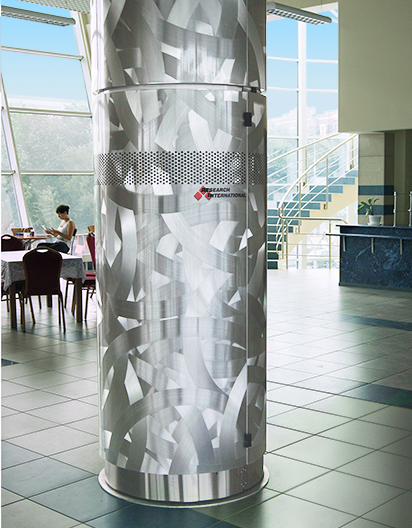ASAP V for Critical Infrastructure Protection
Automated Chemical, Biological and Nuclear Threat Detection
The ASAP V™ for Critical Infrastructure Protection is a modular, multi-sensor surveillance system designed for subways and other high-value/high-risk areas. Sensor modules are available that can detect a wide range of threats, from the presence of nuclear, biological and chemical agents, to smoke and fire.
ASAP V/CIP systems may be configured to uniquely match your particular concerns and budget. A nodal approach is used that allows local or remote monitoring of a single suite of detectors or the monitoring of a number of nodes in different locations. Information from the individual nodes can flow to a central PC-based monitoring system via secure optical fiber, cell phone, Internet, Bluetooth, or other appropriate data linking technology. Research International can supply the following monitoring capabilities: NBC threats, explosives, smoke and fire, video and sound, intrusion, thermal imaging and meterological data.
DOWNLOAD DATA SHEET • REQUEST QUOTE
Product Features
- Nuclear, biological, and chemical (NBC) threat detection
- Smoke and fire detection
- Video and sound monitoring
- Intrusion detection
- Thermal imaging
- Meteorological data
- X-ray detection
- Large area air circulation and sampling methods
- Biological and radiological sample collection and storage
Typical Applications
- Transit systems/subways
- Critical infrastructure protection
- Homeland security
- Air quality
Operational Details
Each node consists of a central instrument box that houses communication electronics and those sensor modules that need to be centrally located, such as the aerosol biohazard module. Others such as video and sound modules may be mounted externally and can be supplied in a cabled format. Research International will work with each customer to provide a customized solution that best meets his requirements.
Windows-based software allows easy integration of the diverse modules. They may be operated stand-alone or in conjunction with other modules in a master/slave mode. A wide range of master/slave connection options and programmed sampling and analysis protocols are provided.
For example, a bio-aerosol detector may be used to detect any unusual increase in the bio-aerosol background. This can be readily accomplished using Research International’s TacBio™ biological aerosol detector. The system can be programmed to provide a visual and/or sound alarm on a monitoring PC, as well as turn on an aerosol sampler that collects particulates into a small volume of water.
When a specified collection time has elapsed, the collected sample will be transferred to a wet bioassay module that determines if suspect biological threat agents are present. Results are then relayed to the local or remote monitoring PC. Such a collection and identification protocol may be completed in about 20 minutes.
 As a second example, a radiation detection module may sense an abnormally high radiation background. The system can be programmed to signal this event to the monitoring PC, and to run a programmed collection protocol using a high-efficiency dry filter system. Research International can provide this functionality based either on the SASS® 3100 or SASS® 4100 dry filter aerosol particle collectors.
As a second example, a radiation detection module may sense an abnormally high radiation background. The system can be programmed to signal this event to the monitoring PC, and to run a programmed collection protocol using a high-efficiency dry filter system. Research International can provide this functionality based either on the SASS® 3100 or SASS® 4100 dry filter aerosol particle collectors.
The Windows-style user interface also provides operators with immediate visual feedback regarding the status of the individual sensors. By a button click, the user can examine each detector’s output over the past 24 hours. Through pull-down windows, each detector’s performance can be examined or adjusted as appropriate for immediate conditions. A permanent record of each module’s data is stored for archival study.
Several of the detection modules are described in the following sections. Contact Research International or its representative for more detailed information.
BIOLOGICAL AGENTS
 Air sampling for bio-aerosols may be implemented using Research International’s SASS® 2300 multiple-effect wet air sampler, or for higher sensitivity, the SASS® 4000 aerosol concentrator may be used to produce an aerosol concentrate. Wet antibody-based bioassays may be performed on-site using bioassay modules based on Research International’s RAPTOR™ four-channel bioassay system.
Air sampling for bio-aerosols may be implemented using Research International’s SASS® 2300 multiple-effect wet air sampler, or for higher sensitivity, the SASS® 4000 aerosol concentrator may be used to produce an aerosol concentrate. Wet antibody-based bioassays may be performed on-site using bioassay modules based on Research International’s RAPTOR™ four-channel bioassay system.
The RAPTOR system uses patented multiple-use assay coupons that provide up to 30 assays before the coupon must be replaced. This greatly minimizes per-measurement and life cycle assay costs for the ASAP V/CIP as compared to other wet bioassay strategies.
CHEMICAL AGENTS
Airborne chemical agents are detected using an ion mobility spectrometer produced by a major world manufacturer. The module offers fast and reliable detection of a wide range of airborne toxic industrial chemicals and chemical warfare agents. The unit provides continuous real time operation with a response time of only a few seconds.
 NUCLEAR MATERIALS
NUCLEAR MATERIALS
Two modules are available based on gamma ray scintillator products. One module is amenable to portal monitoring situations where the presence of radio-isotopes and special nuclear materials are of concern at an entry point to a controlled area. The second module is more suited for area monitoring gamma ray background levels.
METEOROLOGICAL
This module is based on meterological systems provided by Coastal Environmental Systems of Seattle, WA. Sensors can be provided for wind speed and direction, relative humidity, temperature, pressure, visibility, and precipitation. Optionally the system can monitor the area with video.
EXPLOSIVES
The presence of unusual levels of explosive vapors and particulates is determined using a module based on Morpho System’s MobileTrace ITMS technology. Analysis and reporting times are under 10 seconds.
INTRUSION DETECTION
Several intrusion detection technologies are available, based on detection methods ranging from microwave to acoustic. Please let us know what the approximate dimensions (height x width x depth) of your monitored surveillance area are, and the normal operating temperature range, and we will provide one or more recommended solutions.
THERMAL IMAGING
Body temperature imaging (8 to 14 microns, typ.) is an excellent method for performing covert surveillance or fire detection, among other functions. Microbolometer technologies have now made this a cost-effective technology to incorporate into the ASAP II/CIA. Thermal imagers can be installed with arrays ranging up to 96 x 96 in size.
AEROSOL BIO-PARTICLES
A detection module for classifying aerosol particles as being either of biological or non-biological origin is based on Research International’s TacBio UV particle analyzer. This LED-based technology monitors for unusual changes in the level of biological and non-biological aerosols.
Specifications
ASAP V Multi-Threat Detection System
| Characteristic | Description |
|---|---|
| Use profile | Automated/programmed/continuous identification of targeted toxins, viruses, bacteria, spores, industrial chemicals, explosives, and nuclear materials. Batch sample examination also supported. |
| Duty cycle | Continuous. Functional availability >99.3% (1). |
| Air sampling rate | 30,000 liters/min. |
| Toxic Industrial Chemicals Subsystem | Ion mobility spectrometry or long baseline infrared spectrometry. Gas libraries of 15 to 40 targets, depending on technology used. Analysis time less than 10 seconds. |
| Explosives Subsystem | Ion mobility spectrometer; analysis time = 8 seconds. |
| Nuclear materials Subsystem | Area and portal styles available. Typical specifications: 0.05 to 3.0 MeV gamma detection window. Detect 360 kBq of Cs-137 and 6 gm Pu(2); neutron detection optional. |
| Video Subsystem | Up to1280 x 720 (HDTV) resolution + sound |
| Thermal Video Subsystem | Up to 640 x 480 (VGA) + sound |
| X-Ray Subsystem (2) | |
| Sensitivity | 40 gauge wire typical, 38 guaranteed |
| Penetration | 39 mm steel typical, 37 mm guaranteed |
| Contrast Sensitivity | 24 visible levels, 4096 gray levels |
| Bioassay Subsystem | |
| Bioidentification - Manual | Immunoassay test strips and machine reader: 12 minutes typical overall time |
| Bioidentification-Automated | Four simultaneous assays performed on 1 cc samples using a credit card-size assay coupon. Coupon and associated re-useable reagents provide from 20 to 30 assays over a 48 hour use period. 15 to 30 minute combined collection and identification period |
| User Interface | Windows® user interface. |
| Physical Size | Depends on user requirements. Architectural column-style design is typically 0.9 meters diameter x 3 to 4 meters high. |
| Temperature range | Operating: For systems that do not support liquid-based bioassays, -20° to 60°C; for liquid-based bioassay systems, above freezing to 50°C. |
| Alarms | Large green/amber status light; annunciator optional. |
| Communication | TCP/IP Connectivity. RS-232 bi-directional serial link is standard. |
| Data storage/programmability | Raw/processed data storage at each monitoring node. Operating protocols are reprogrammable through an external communications link. |
| Power Consumption | 750 watts typical with 30,000 LPM air circulation system installed. |
| Humidity | 5% to 95%, non-condensing. |
NOTES:
(1) Functional availability is the percentage of total work time the system is functional, averaged over a 90 calendar day period.
(2) Search volume: 0.7m diameter X 2m length. Object speed 5 Km/hr. Detection probability 50% at 95% confidence level, 0.17
false alarm rate, 20 ur/hr. background.
Research International, Inc. reserves the right to change specifications or product source without prior notice.




